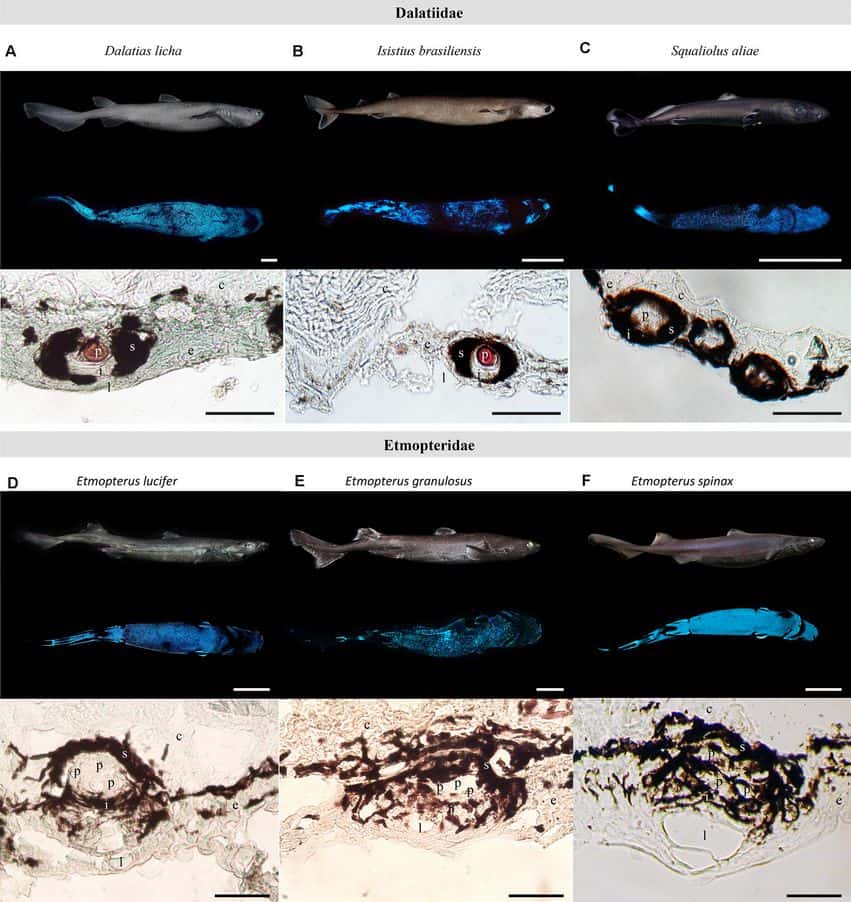An international team of scientists discovered three species of sharks: Dalatias licha, Etmopterus lucifer, and Etmopterus granulosus, turned out to be bioluminescent.
To date, the bioluminescence of sharks has not been well documented, nor has it been thoroughly studied. Marine biologists Jerome Mallefet and Laurent Duchatelet, from the Catholic University of Leuven (Belgium), have led the effort to change this.
- Neuroscience Breakthrough: Study Pinpoints Brain Activity That Helps Prevent Us From Getting Lost
- Brief Anger Hampers Blood Vessel Function Leading to Increased Risk of Heart Disease and Stroke – New Study
- New Blood Test Pinpoints Future Stroke Risk – Study Identifies Inflammatory Molecules as Key Biomarker
- Enceladus: A Potential Haven for Extraterrestrial Life in its Hidden Ocean Depths
- New Experiment: Dark Matter Is Not As ‘DARK’ As All We Think
Thanks to their work done in cooperation with Darren Stevens of the National Institute for Water and Atmospheric Research (New Zealand), it has now become known even seal shark is indeed bioluminescent. Various scientists have suspected it since the 1980s.
All three species have blue patterns that glow softly on their skin and this is news for sharks that inhabit New Zealand waters. Of these three, kitefin shark (also named seal shark or black shark), which reaches 180 centimeters in length and has a worldwide presence, can now be considered the largest bioluminescent shark in the world.

Of hundreds of sharks caught, the scientists studied 13 black sharks, 7 Etmopterus lucifers, and 4 Etmopterus granulosus. In the skin of the three species, they managed to find photophores, an organ that emits light in bioluminescent animals.
It is curious that sharks are the only species in which the emission of light is hormonally controlled. In particular, the researchers found that, in all three species, melatonin triggers the glow, alpha melanocyte stimulates it, and corticotropin turns it off.
Why do sharks shine? It is a difficult question to answer. Like all animals in the mesopelagic zone, which lies between 200 and 1,000 meters below the surface of the water, they can glow for many reasons: to attract a mate or prey and to camouflage themselves.
Scientists believe that the concentrated glow around the belly and underside could help make these fish virtually invisible from certain angles. Further study of these species would allow us to understand how the deep-sea ecosystem works as a whole.
“This first experimental study of three luminous shark species from New Zealand provides an insight into the diversity of shark bioluminescence and highlights the need for more research to help understand these unusual deep-sea inhabitants: the glowing sharks,” write the authors of the study published by the Frontiers in Marine Science magazine.
- Neuroscience Breakthrough: Study Pinpoints Brain Activity That Helps Prevent Us From Getting Lost
- Brief Anger Hampers Blood Vessel Function Leading to Increased Risk of Heart Disease and Stroke – New Study
- New Blood Test Pinpoints Future Stroke Risk – Study Identifies Inflammatory Molecules as Key Biomarker
- Enceladus: A Potential Haven for Extraterrestrial Life in its Hidden Ocean Depths
- New Experiment: Dark Matter Is Not As ‘DARK’ As All We Think
Bioluminescence is fairly common property. It is useful for the forms that live in the dark: fungi, insects, and marine inhabitants. In the mesopelagic zone, bioluminescence is practically a way of life. Over 90% of all animals living at this depth are believed to develop some form of bioluminescence that they use in different ways.